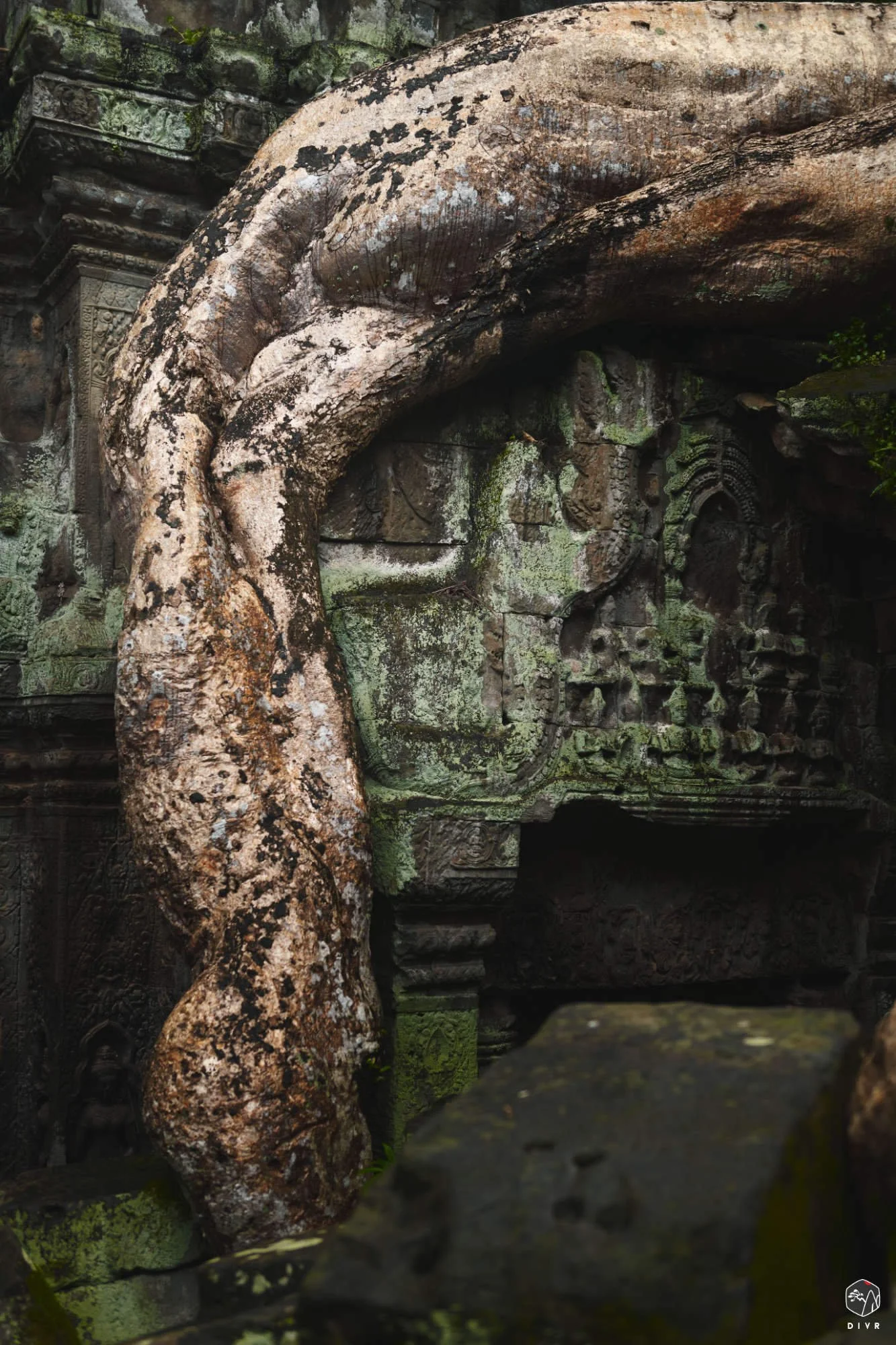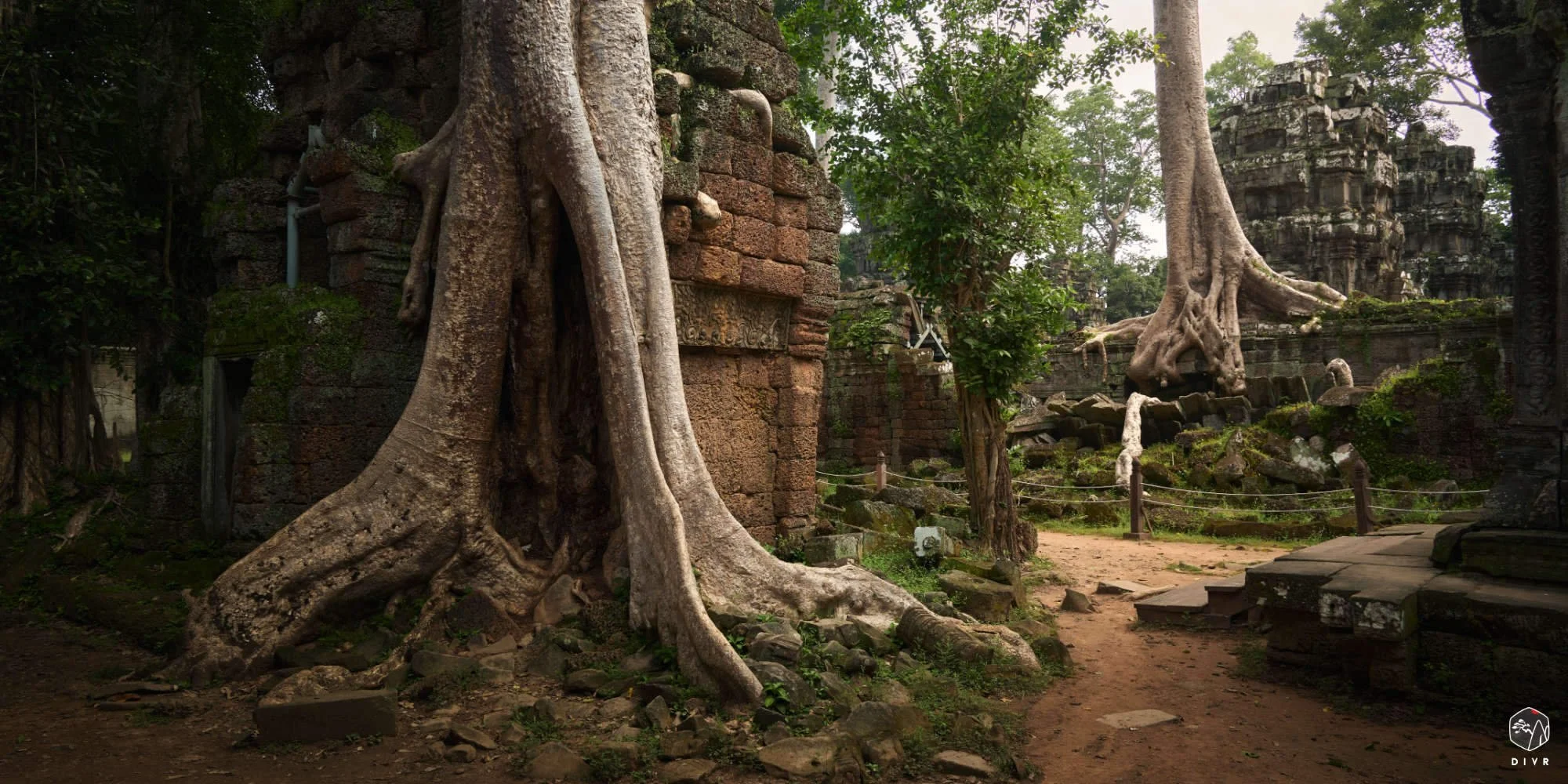Ta Prohm Temple
As photographers, we often face the challenge of capturing both the grandeur and the subtle beauty of a place. When I visited the Ta Prohm Temple in Cambodia, I knew it would be the perfect spot to take on this challenge. Ta Prohm, famous for its giant trees growing through the temple ruins, offered an ideal setting for a photographic adventure focused on selecting a personal theme.
Welcome to the entrance of Ta Prohm… (yes, there’s a chicken in the bottom left!)
Nature Reclaims Its Place
The Temple of Ta Prohm is not just a Cambodian temple; it’s a place where nature has truly taken back control, with towering trees, their roots invading the ruins. The most striking feature of this temple is the way nature and history intertwine, creating an atmosphere where time seems to stand still. The roots of the trees weave through the stones, giving the site a unique, magical quality.
I’ve always been drawn to the power of nature, and here it contrasts beautifully with human structures. At Ta Prohm, the dynamic interplay between the trees and the way they envelop the ruins makes the place feel alive, as if nature itself is reclaiming what was built by humans. This theme of nature overtaking civilization became the foundation of my photography during my visit.
One of the temple’s most famous giant tree. Here, you can see the incredible texture of its trunk, but this is what it’s growing on:
On a door! Unbelievable…
Choosing a Photographic Theme
As any photographer knows, one of the biggest challenges when visiting a highly touristic site is the crowd. At Ta Prohm, this was no different: groups of tourists and other photographers flooded the place. So, how do you capture personal images in such a busy environment?
For me, the key was focusing on a specific theme. Instead of trying to photograph everything or capture wide shots of the temple in a single frame, I chose to focus on the relationship between nature and the temple’s ruins. By emphasizing this theme, I was able to sidestep the “tourist distractions” and create images that felt personal and unique.
Choosing a theme also allowed me to experiment with different angles, compositions, and camera settings based on my interpretation of what I saw. Whether it was the way tree roots wrapped around stone pillars, covered in lichen, moss, or bare, I focused on capturing moments that spoke to the larger theme: nature reclaiming its place.
Here, it was the chaos undoubtedly caused by this tree that caught my attention, along with the stunning moss growing on the ruins…
One of my favorite photos from my visit. For me, the appeal lies primarily in the contrast of shapes between the straight wall and the gracefully twisting tree.
Techniques for Capturing the Beauty of Ta Prohm
While choosing a theme is essential, the technical aspects of photography are just as important. Upon arriving at the temple, I had to wait to photograph between groups. I wanted to capture the location without anyone, but that wasn’t always possible, so I used multiple exposures to remove visitors during the editing. If you want to know how to do this, check out my video on the subject; the link is in the video at the bottom of the page.
When I had the space to myself, I began focusing on details. One of the iconic viewpoints at Ta Prohm is this massive tree growing along a corridor in the temple, with its roots resembling huge snakes. I chose to zoom in to create compositions that highlighted the interaction between the tree, the stone, and the surrounding vegetation.
Another one of my favorite photos. I love how this root both blends into the wall and stands out due to its more rounded shape. It’s a small detail of the s”nake roots” that you can see in full in the video.
There was a wall under these roots…
A key to creating striking images is depth. I used a wide aperture (f/8) to keep both the distant tree and the foreground one sharp. This also helped guiding the viewer’s eye through the composition. The elevated position of the tree roots gave the scene a sense of grandeur and majesty, which I was eager to convey in these photos.
The Importance of a Polarizing Filter
Another key tool in my gear set is my polarizing filter (CPL). This filter is essential for cutting reflections, particularly on the leaves, created by the natural oils that protect them. It also helps to saturate the colors of the leaves, making the image more vibrant and rich.
If you’re photographing nature, a CPL is a madatory accessory. I can’t recommend it enough. Check out the video for a comparison, an image is worth a thousand words.
Giving Personal Meaning to Your Photos
When visiting a popular tourist site like Ta Prohm, it’s easy to feel compelled to take photos that merely document the place. But for me, the true joy of photography lies in capturing something personal, something that will remind me of the moment and the emotions experienced there. I encourage you to reflect on your own experience when photographing a location: don’t just take a photo of the monuments. Find details that resonate with you and focus on them.
For example, I was amazed to discover in several places that plants were growing right out of the roots of these silk-cotton trees. The ruins are the cradle of these trees, and their roots are the cradle for these new plants. Magical!
This focus on details not only makes your photos more interesting, but it also ensures that your images tell a story: a story that belongs to you, your story. After all, photography is not just about documenting a place, but about capturing an emotion or a memory that will last much longer in your mind.
Long live this young sprout!
This tiny detail (relative to the trunk that hosts this sprout, for us it’s a human-sized knot!) perfectly sums up life in this temple: resilient.
Take Photos That Tell Your Story
The experience of photographing the Temple of Ta Prohm was truly incredible. The temple itself, with its amazing fusion of nature and ruins, became the perfect subject for my photography. But what made this experience truly special was the opportunity to focus on a theme that resonated with me and create photos that were meaningful to me.
So, the next time you visit a popular place—whether it’s a temple, a city, or a landscape—remember to choose a theme for your photography. Don’t just take photos to show others where you’ve been; take photos that will remind you of the emotions, details, and stories of your visit. This approach will make the process more rewarding and ensure that you return with images you will cherish for a long time.
These trunks, competing for space in an entrance basin, had remarkable textures.
This tree found another way in!
Thank you for joining me on this journey through Ta Prohm, Cambodia. I hope this blog has inspired you and will be helpful for your own photographic adventures. Until next time, keep exploring, keep photographing, and remember to focus on what matters to you in every frame!
I run a YouTube channel where I share more landscapes and photos. Feel free to check it out for your enjoyment, and if you’re inclined, support me by liking, subscribing, and sharing. I appreciate it in advance.
This week’s video is here:
If you want to hike with me, whether for photography or just for fun, check here!
If you want to see more images of natural beauties in Korea, or talk to me directly, follow me on Instagram @romainphoto_outside.
If you have any questions about landscape photography or Korea's nature, let me know in the comments section below. Also, please share my blog so that, one day maybe, I can meet you on a hike!
À bientôt!




